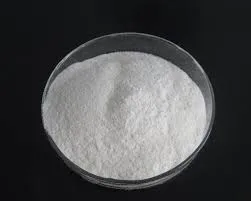
Jul . 27, 2024 11:02 Back to list
Hydroxypropyl Methyl Cellulose Production and Applications in Various Industries Explained
HPMC The Versatile Polymer from Leading Manufacturers
Hydroxypropyl Methylcellulose (HPMC) is a widely utilized polymer that has found applications across various industries, thanks to its unique properties and versatility. As a product developed and manufactured by numerous companies, HPMC plays a crucial role in enhancing the functionality of many consumer products, from pharmaceuticals to construction materials. This article explores HPMC's characteristics, applications, and the leading manufacturers in the field.
What is HPMC?
HPMC is a semi-synthetic polymer derived from cellulose, a naturally occurring biopolymer found in plants. It is produced by reacting cellulose with propylene oxide and methyl chloride, resulting in a modified cellulose that exhibits improved solubility and chemical stability. This modification gives HPMC a range of functional properties, including thickening, gelling, film-forming, and water-retention capabilities, making it an invaluable ingredient in many formulations.
Applications of HPMC
The applications of HPMC are extensive and diverse
1. Pharmaceuticals HPMC is widely used in the pharmaceutical industry as a binder, stabilizer, and controlled-release agent in tablets, capsules, and other dosage forms. Its biocompatibility and inertness make it an ideal choice for drug formulations.
2. Food Industry In food products, HPMC serves as a thickener, emulsifier, and texturizer. It helps to improve the consistency and mouthfeel of various food items, including sauces, dressings, and baked goods.
3. Construction In construction, HPMC is valued for its water-retention properties and workability in cement and plaster mixtures. It enhances adhesion, prevents crack formation, and increases the open time of mortars and other building materials.
hpmc-hydroxypropyl methyl cellulose manufacturer

4. Personal Care Products HPMC is commonly found in cosmetic and personal care formulations for its thickening properties. It is used in products like lotions, creams, and shampoos to enhance texture and stability.
Choosing a Leading HPMC Manufacturer
When selecting an HPMC manufacturer, several factors must be considered to ensure product quality and reliability. The leading manufacturers of HPMC focus on
1. Quality Control Top manufacturers adhere to strict quality control protocols and regulatory standards to ensure their HPMC meets the required specifications and is safe for use in various applications.
2. Innovative Formulations Leading companies invest in research and development to create innovative formulations that cater to evolving market needs, offering customized solutions for specific applications.
3. Global Reach A reputable HPMC manufacturer typically has a strong international presence, supplying products to various markets around the globe. This global reach often translates to better scalability and availability of products.
4. Sustainability With increasing concern over environmental issues, many leading manufacturers are focusing on sustainable practices in HPMC production, utilizing renewable resources and minimizing waste.
Conclusion
Hydroxypropyl Methylcellulose is a remarkable polymer that has made significant contributions to various industries. Its unique properties make it an indispensable ingredient in pharmaceuticals, food products, construction, and personal care items. As the demand for high-quality HPMC continues to rise, manufacturers that prioritize quality, innovation, and sustainability will lead the market. By understanding the capabilities and applications of HPMC, industries can leverage this versatile polymer to enhance their products and meet consumer expectations effectively.
-
Versatile Hpmc Uses in Different Industries
NewsJun.19,2025
-
Redispersible Powder's Role in Enhancing Durability of Construction Products
NewsJun.19,2025
-
Hydroxyethyl Cellulose Applications Driving Green Industrial Processes
NewsJun.19,2025
-
Exploring Different Redispersible Polymer Powder
NewsJun.19,2025
-
Choosing the Right Mortar Bonding Agent
NewsJun.19,2025
-
Applications and Significance of China Hpmc in Modern Industries
NewsJun.19,2025







